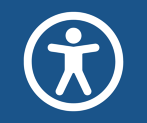
A note from Donna
When I first launched this newsletter, my goal was to provide regular updates, guidance, and resources to help improve digital accessibility across DPI and PSUs. Yet, it has been over two months since I published the last newsletter…
The reality of this work is that it touches everything: every department, every PSU, every website, every digital platform, every classroom, every document, every video, every online instructional resource. The scope is immense, and like all of you, I am constantly navigating competing priorities and limited capacity.
I understand how overwhelmed you may feel as you consider all there is to learn about accessibility, especially when the compliance start date for meeting the ADA title II rule requirements is on the horizon. There is always more to do, and progress often feels slow. But change is happening, even in the smallest actions we take.
Judith Heumann, a lifelong disability rights activist, captured this so well in her words, and I turn to this quote when I need a bit of encouragement.
Change never happens at the pace we think it should. It happens over years of people joining together, strategizing, sharing, and pulling all the levers they possibly can. Gradually, excruciatingly slowly, things start to happen, and then suddenly, seemingly out of the blue, something will tip.
-Judith Heumann, Being Heumann: An Unrepentant Memoir of a Disability Rights Activist
Every action, whether it’s learning one new accessibility strategy, or updating one document to make it more usable, or asking a vendor about the accessibility of their product, moves us forward. Some of those actions may feel insignificant, but they are all levers to shift the landscape forward, to ensure accessibility for all.
As some of you know, this work is also deeply personal to me. My daughter Olivia has both physical and cognitive disabilities. She experiences the world differently than many of her neurotypical peers, and technology plays a crucial role in how she learns, interacts, and navigates daily life. I know firsthand how much accessibility matters, not just in legal compliance, but in making sure people like my Olivia can fully participate in school, work, and society. I am passionate about removing barriers, both as an educator and a parent.
So, whether you’ve been working on accessibility for years or are just beginning to explore the “what, why, and how” of accessibility, I encourage you to take one step forward.
Pull one more lever.
I feel change starting to tip.
If you’re wondering where to start, I’ve linked a few resources below. And as always, I’m here to help.
Yours in accessibility,
Donna
Did you miss the last newsletter? Find links to all previous newsletters on the NCDPI Digital Accessibility website.
|
News & Updates
Upcoming webinars
- February 24, 2025 - 11:00 AM-12:00 PM: Accessible Design Using Canva webinar
Explore strategies for creating visually engaging yet accessible content. Learn how to use Canva’s built-in accessibility features, apply accessibility strategies, and ensure your designs work for all users. Whether you're creating presentations, social media graphics, or documents, this session will help you design with accessibility in mind. (Webinar will be recorded.)
- March/April 2025: A webinar series designed specifically for vendors who develop digital solutions for K-12/higher education, state government and/or local government entities. Email invitations have been sent to hundreds of vendors, but please also share with your vendor contacts!
Ensuring that digital products and services are accessible is not only about legal compliance; it is a commitment to providing solutions that are accessible to all users. This webinar series will provide foundational knowledge and practical guidance on integrating accessibility into product design, development, procurement, and customer support. Vendors may register for any or all webinars in the series.
- March 4: Introduction to Digital Accessibility
- March 11: Assessing Your Organization’s Accessibility Maturity
- March 18: Building a Strategic Accessibility Plan
- March 25: Creating an Accessibility Conformance Report
- April 1: Collaborating to Ensure Accessibility for All
- April 8: Addressing Accessibility in Student-Facing Educational Materials
Legal landscape
The FTC recently fined an online marketer $1 million for deceptive claims about its AI product’s ability to improve website accessibility. This serves as a critical reminder to vet accessibility claims carefully, whether from vendors, automated tools, or AI-powered solutions. No AI product can fully replace human expertise in ensuring compliance with WCAG standards and meeting legal requirements like the ADA Title II rule.

Resource Spotlight:
Digital Accessibility Website Updates
There have been numerous updates to the Digital Accessibility website over the last couple of months. If you haven’t explored the site lately, I encourage you to do so. A few highlights:
-
Evaluating digital content for accessibility: what automated checkers can and cannot do, tips for completing a manual review, strategies for engaging users with disabilities in your review
-
PSU resources: planning and inventory templates, tips and sample language for creating an accessibility statement, sample workflow to address reported accessibility issues
-
Project/procurement: addressing accessibility in projects, strategies for risk management, what to ask vendors and how to evaluate the accessibility of products, guiding questions for determining “undue burden” or “fundamental alteration” exceptions, resources for suppliers
|

Accessibility Insights:
External Events and Resources
External events
- February 25-27, 2025: axe-con 2025 is a free, virtual conference focused on digital accessibility, bringing together industry leaders, developers, designers, and accessibility advocates to share best practices, insights, and innovations for building inclusive digital experiences.
- March 18, 2025: Ability Summit (Microsoft) The 2025 Ability Summit is a free digital event where you will find the latest in AI and accessibility. Everyone is welcome to attend and learn with experts from across the globe.
Resource
Ada.gov: new ADA title II rule resource: This resource can help you plan what steps your state or local government might want to take to begin complying with the rule. Public entities don’t have to comply with the rule until April 2026 or April 2027, depending on their size. But creating and maintaining accessible content takes planning. This resource makes some suggestions to help state and local governments with that planning.
|

Understanding WCAG: Writing Descriptive Links
In each newsletter, we will focus on an accessibility topic and its relevant WCAG 2.1 standard(s).
When creating links in web pages or documents, the text you choose for each link plays a critical role in accessibility. Phrases like “Click here” or “Read more” might seem harmless, but they can create confusion, especially for users who rely on screen readers or who navigate content using a keyboard.
Screen reader users often navigate from link to link, reading only the link text, so vague phrases fail to provide the necessary context about where the link leads.
Descriptive links are helpful for everyone, not just assistive technology users. They improve navigation, enhance usability, and support better understanding of your content.
Tips for creating accessible links
- Use clear, descriptive text: Ensure the link text explicitly describes its purpose or destination. For example, instead of saying “Click here,” use text like “View our 2024 event calendar” or “Download the parent handbook.” This helps all users understand what the link offers.
- Keep links meaningful out of context: Write link text that makes sense on its own, without relying on the surrounding content. For example, “Schedule a tutoring appointment” is clear, while “Click here to schedule” is not.
- Avoid overly long link text: While the link text should be descriptive, it doesn’t usually need to be an entire sentence. Be concise but clear (e.g., “Apply for financial aid” instead of “Click here to read about how to apply for financial aid”).
Additional tips for link formatting
- Make links visually distinct: Ensure links are visually recognizable, typically done through underlining or a color change. Avoid relying solely on color to indicate links, as this can be inaccessible for users with visual impairments like color blindness.
- Avoid embedding long URLs: Instead of pasting a raw URL like “http://example.com/resources/document1234.pdf,” use descriptive link text such as “Resource Guide (PDF).”
Benefits of descriptive links
Writing descriptive link text isn’t just about meeting accessibility standards; it’s about creating a better experience for everyone. Thoughtful link design helps all users navigate content more easily, can reduce cognitive load, and provide clear context and purpose for linked content.
Relevant WCAG standards
-
WCAG 2.4.4 Link Purpose (In Context) (A): The purpose of each link can be determined from the link text alone or from the link text together with its programmatically determined link context, except where the purpose of the link would be ambiguous to users in general.
-
WCAG 2.4.9 Link Purpose (Link Only) (AAA - optional): A mechanism is available to allow the purpose of each link to be identified from link text alone, except where the purpose of the link would be ambiguous to users in general.
|
Digital Accessibility Through Lived Experience
3D printing with Be My AI?
In this video interview, Grace, a visually impaired student, is using Be My AI for what she calls “STEM without sights.” With Be My AI, Grace is accessing her 3D printer independently to create Braille beads to spread Braille awareness.

NCDPI Digital Accessibility:
Building A11y Champions!
|
If you have ideas for topics you'd like to see covered in the newsletter, or would like to contribute to a future edition, please reach out via email.
References/links to external websites or tools do not constitute endorsement. Information and guidance should not be considered legal advice.
|